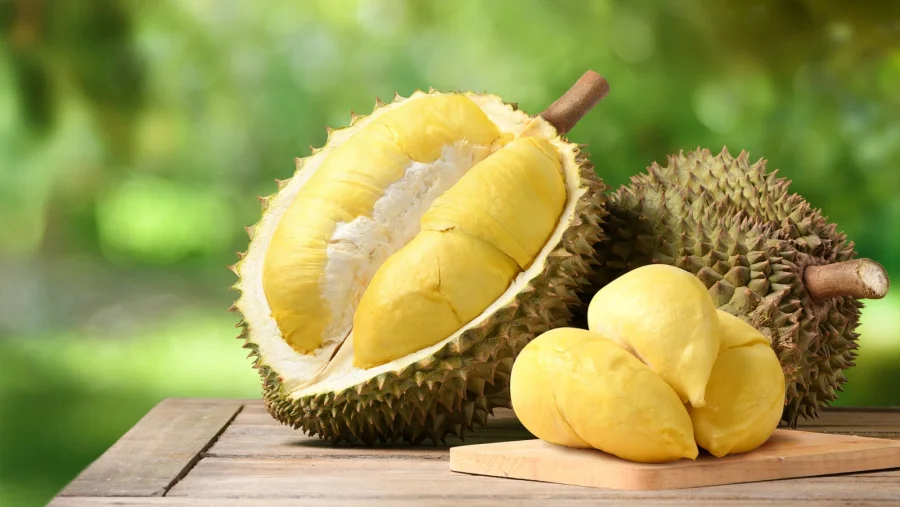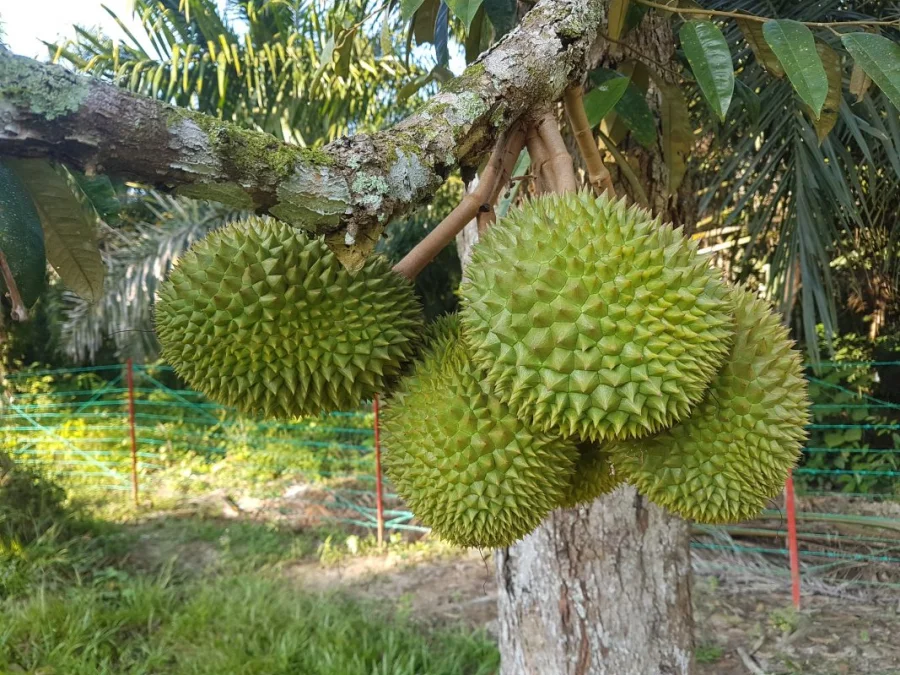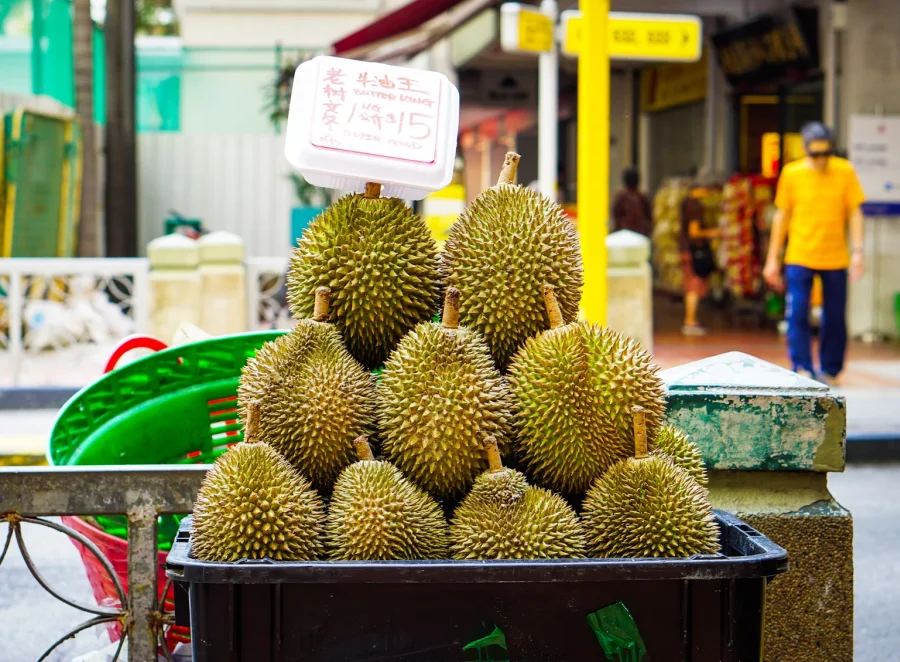
Revered and reviled, celebrated and banned, few fruits command the same level of intense reaction as the durian.
Hailing from Southeast Asia, this formidable, spiky behemoth holds the undisputed title of “King of Fruits” in the region. This regal moniker stems not just from its large size and thorny crown-like husk, but also its rich, complex flavour and significant cultural standing.
Yet, its reign is controversial, primarily due to its notoriously potent aroma, an odour so pervasive and unique that it leads to frequent bans on public transport and in hotels across Asia.
Durian is more than just a fruit; it’s a cultural icon, an economic powerhouse, and an unforgettable sensory experience.
History & Origins
The story of durian begins in the dense rainforests of Southeast Asia, with Borneo and Sumatra widely considered its primary native regions.
Early cultivation and appreciation of the fruit spread throughout Malaysia, Indonesia, Thailand, the Philippines, and neighboring areas centuries ago.

While precise historical records are sparse, durian quickly became integrated into local economies through trade and agriculture.
Its cultural significance varies across nations; in some, it’s a symbol of abundance and festivity, used in traditional ceremonies or given as a prestigious gift, while in others, it’s simply a beloved seasonal treat eagerly anticipated by locals.
Characteristics of Durian
Instantly recognizable, the durian fruit boasts a hard, thorny husk, typically ranging in color from green to brown depending on ripeness and variety.

Beneath this formidable exterior lies the prized edible part: large seeds enveloped in fleshy, custard-like pods or arils.
There are hundreds of registered durian varieties, each with subtle differences in flavour, texture, and aroma – popular examples include Monthong, D24, and the highly sought-after Malaysian Musang King.

The fruit’s infamous smell is attributed to a complex cocktail of volatile sulfur compounds, producing scents described variously as resembling rotten onions, gym socks, or turpentine, yet often simultaneously sweet and appealing to enthusiasts.
The texture is typically rich and creamy, sometimes bordering on fibrous, while the taste profile is exceptionally complex, offering a blend of sweet, savory, and occasionally slightly bitter notes unlike any other fruit.
Durian Health Benefits & Nutritional Value
Beyond its unique sensory experience, durian offers significant nutritional value. It is packed with energy and is a rich source of dietary fiber, crucial for digestive health.
The fruit contains notable amounts of vitamins, particularly Vitamin C and various B-complex vitamins like thiamine, riboflavin, and niacin.
It’s also loaded with minerals such as potassium, manganese, copper, and magnesium.
Potential health benefits associated with moderate consumption include boosting energy levels, supporting muscle function (thanks to potassium), and providing antioxidants that help combat oxidative stress.

However, myths and misconceptions abound; one common belief is that durian is excessively “heaty” and should not be consumed with alcohol, a caution supported anecdotally due to potential digestive discomfort and metabolic effects, although rigorous scientific evidence is limited.
Like any calorie-dense food, moderation is key.
Culinary Uses & Recipes
The most traditional and arguably best way to experience durian is by eating the flesh fresh from the husk, allowing its complex flavours and creamy texture to dominate the palate.
However, its culinary uses extend far beyond simple consumption. Durian is a star ingredient in a vast array of desserts throughout Southeast Asia.
It’s commonly incorporated into ice cream, cakes, pastries, pancakes, and puddings. Sticky rice served with sweetened coconut milk and fresh durian pulp is a classic and beloved combination.
In some regions, fermented durian paste, known as tempoyak, is used as a pungent condiment or ingredient in savory dishes, showcasing the fruit’s versatility.
Economic & Environmental Impact
Durian cultivation represents a significant agricultural sector and a major cash crop for several Southeast Asian countries, particularly Thailand, Malaysia, and Indonesia.
The economic impact is substantial, driven by both strong domestic demand and burgeoning export markets, with China being a particularly large importer.
However, farming challenges are numerous, including susceptibility to pests and diseases, the need for specific climatic conditions, and the long maturation period of durian trees.
Sustainability efforts are increasingly important, focusing on responsible land use and integrated pest management.
Conversely, the rising global demand has led to environmental concerns, primarily regarding deforestation as natural habitats are sometimes cleared to make way for lucrative durian plantations.
Cultural Perspectives & Controversies
Few fruits elicit such strong reactions as durian, fostering distinct cultural perspectives and ongoing controversies.
Its powerful aroma has led to widespread bans on carrying or consuming the fruit in confined public spaces like hotels, airports, and public transportation systems across Southeast Asia and beyond.

This practical measure highlights the deep love-it-or-hate-it divide: for enthusiasts, the smell is an alluring perfume promising deliciousness, while for detractors, it’s an unbearable stench.
This polarity is part of its identity. Despite, or perhaps because of, its controversial nature, durian is celebrated with dedicated durian festivals in producing regions, attracting tourists and locals alike for feasting and appreciation of different varieties.

Conclusion
In summary, the durian undeniably earns its title as the “King of Fruits” through its imposing appearance, rich nutritional profile, complex flavour, and deep cultural roots in Southeast Asia.
Its unique appeal lies precisely in its contradictions – the challenging aroma guarding a delectable reward, its status as both a delicacy and a source of public nuisance.
While its global reputation remains polarized, the durian’s significance as a culinary icon, economic powerhouse, and cultural symbol in its native lands is indisputable, ensuring its fascinating reign continues.
Q&A
Why is durian fruit banned?
Durian isn’t universally banned, but its incredibly potent and lingering odor leads to restrictions in specific places. Due to the smell, which many find unpleasant and which permeates enclosed spaces easily, it’s often prohibited on public transport (like subways and airplanes), in hotels, and in some other public buildings to avoid offending others and prevent the difficult-to-remove scent.
What does durian actually taste like?
Describing durian’s taste is notoriously difficult as it’s complex and unique. Many find it has a rich, sweet, and creamy custard-like flavour, sometimes with notes of almond, caramel, or vanilla. However, it can also possess savoury undertones, sometimes described as slightly oniony or garlicky, which combined with the sweetness, creates a flavour profile unlike any other fruit – often polarizing people into loving or hating it.
Why is durian so stinky?
The infamous smell of durian comes from a complex cocktail of volatile sulfur compounds (VSCs) within the fruit’s flesh. These are similar to compounds found in onions, garlic, and even rotten eggs or skunk spray, but combined in a unique way. This potent aroma likely evolved to attract animals from afar in the dense jungle, helping with seed dispersal, but it’s this same pungent mix that makes it offensive to many human noses.
Why do I feel sick after eating durian?
Feeling unwell after eating durian can happen for a few reasons. It’s very rich in fats and sugars, and eating too much can simply lead to indigestion or feelings of heaviness, much like overindulging in any rich food. Some cultures also consider durian a “heaty” food that can cause discomfort if eaten in excess. Additionally, its sulfur compounds can sometimes cause burping or mild digestive upset, and importantly, consuming durian with alcohol is strongly advised against as it can hinder alcohol metabolism and potentially cause severe reactions.